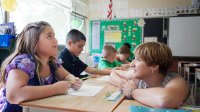4 Ways to Keep Students Moving Forward
A look at a few ways to guide elementary students who may still be struggling with their learning after the last two turbulent years.
The last two years have been difficult for students, and even though we’re well into the current school year, some students may not be quite at the developmental place that educators expect. The challenge for teachers is how to truly meet every student where they are so that they continue their progress.
Here are four strategies that elementary teachers may find useful in taking on this challenge and bridging any learning loss that students may still be managing.
1. Reduce Stress
The pandemic has created a great deal of stress and anxiety. While students of color and low-income students were inordinately impacted by the pandemic, students across all identities and family backgrounds experienced loss of loved ones, family stress due to job losses and financial strain, separation from friends, and fear of a global illness that was out of their control.
The link between stress and executive function is undeniable. Executive functions include memory, attention, planning, and organization of thoughts, skills that are essential for both schoolwork and daily life. When executive function is impaired, students may experience difficulty with following directions, regulating emotions, and even just paying attention. Knowing this is important because if children are stressed, they’re not ready to learn. In order to create an optimal learning environment, therefore, we must find ways to reduce stress in the classroom.
We can do this in numerous ways, including building a community of support and trust in the classroom, using warm-up activities, incorporating breathing exercises and other mindfulness practices, and creating low-stakes/formative assessments that help students build their skills and promote a growth mindset. Take advantage of this stage of development as one where students are excited about learning and being playful. Being stuck at home might have limited the time they could socialize and play with others. Leading with ways to reduce stress through community building and playful social interactions is always a good idea but perhaps needed now more than ever.
2. Use Stories
We have long known that stories have a privileged status in the brain, and teachers can capitalize on that to engage students and enhance their learning. Stories create an effective connection to content. When we care about something, we think about it more. Great stories have conflict and compelling characters. Moreover, stories are part of many cultural traditions. Unfortunately, many textbooks exclude the suspense and conflict that make subjects like history and science come alive. Teachers can remedy this by connecting what students are learning to their lives.
The website Newsela allows teachers to (re)set the reading level of an article so that children can get the same key information no matter their level. It’s a way to share with students what’s happening today and encourage them to share their own stories and connect them to their learning. The more students find that what they’re learning is relevant to their lives, the greater their connection and motivation to learn. A middle grades chapter book that does this well is Clean Getaway, by Nic Stone, the story of a child and his grandmother that gently weaves in important historical events.
3. Value Local Knowledge
Valuing local knowledge means that teachers accept, respect, and appreciate the knowledge that students bring to the classroom. In some ways, this is an extension of the idea of using stories to make effective connections. During the pandemic, although some children may have experienced learning loss based on traditional academic metrics, many students experienced the benefits of being home with family, perhaps taking on helpful roles at home that built skills ranging from household repair and cooking to tutoring younger siblings.
This approach of finding the benefits of the connections between home and school is sometimes referred to as “funds of knowledge.” While many of us are worried about what students lost during the pandemic, we can also take some time to focus on what they learned. Creating opportunities for children to use journals to tell their stories, make connections to texts they read, and express their thoughts creatively can be invaluable.
4. Teach to the Edges
When I was learning how to teach, I was told, “Plan to the middle, and differentiate for the children who need more support or more challenge.” Now I know better. Utilizing the principles of Universal Design for Learning creates classrooms where everyone can be successful. The idea of teaching to the edges is an acknowledgment that every classroom has neurodiversity, a variety of learning preferences, and myriad talents.
That isn’t to say we need an individual plan for every student—that isn’t feasible. However, by incorporating multiple means of engagement, representation, and expression throughout instruction, we are more likely to capture the imagination of our students, increase motivation, and meet their individual needs.
